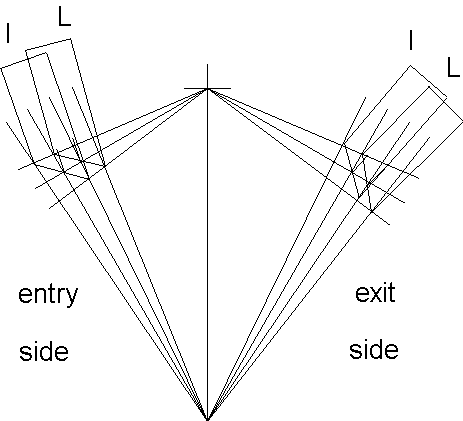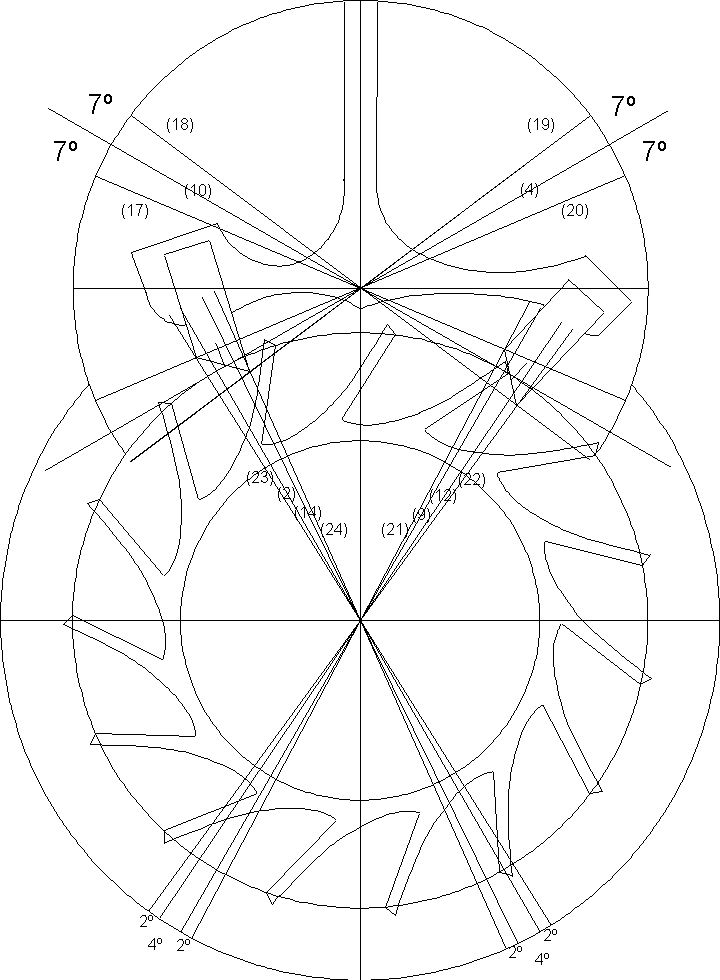14: Changing the Design
A different approach is required to create different designs, such as the equidistant
lock drawing below. Rotate lines (14) and (12) clockwise by 4º to get lines (15) and (16)
respectively. Rotate lines (10) and (4) clockwise by 7º to get lines (18) and (20), and
counterclockwise to get lines (17) and (19). Draw the entry pallet's impulse face from the
point where lines (2) and (20) intersect to the point where lines (15) and (19) intersect.
Draw the exit pallet's impulse face from the point where lines (9) and (17) intersect to the
point where lines (16) and (18) intersect. Rotate lines (2) and (9) clockwise by 15º to
draw the locking faces of the pallets. In order to maintain the action of the pallets as
symmetrical as possible (and to keep the impulse face's angle as close to 45º as possible),
the lift is reduced slightly to 14º and the impulse angles are no longer at 45º, which
reduces efficiency, but the lock and drop are the same on both sides and the pallets are
not "out of angle." The pallets are no longer identical.
 |
Drawings could be superimposed for comparison, such as this comparison between
the equidistant impulse and lock designs. It reveals that, in the equidistant impulse
design, the exit pallet's impulse face does not exactly fit between the lines: while the exit
pallet is identical to the entry pallet, it is not a mirror image of the entry pallet. The entry
pallet does not have a perfect fit either, but the difference is very small and
inconsequential. The result of the unequal fit on both sides is that the exit pallet releases
the escape tooth a little prematurely, causing the design to be out of angle: the angle on
the left side to the drop-lock position is one degree greater than on the right side. This
problem is corrected in Chapter 22.
 |
To combine the advantages of equidistant impulse and equidistant lock,
watchmakers have designed an escapement half way between the two, called the
Semi-Tangental Escapement. Here, the angle between lines (2) and (23) and between lines
(9) and (21) is 2º, so rotate lines (2) and (9) counterclockwise by 2º to get lines (23) and
(21). Rotate lines (12) and (14) clockwise by 2º to get lines (22) and (24). Draw the entry
pallet's impulse face from the point where lines (23) and (20) intersect to the point where
lines (24) and (19) intersect. Draw the exit pallet's impulse face from the point where
lines (21) and (17) intersect to the point where lines (22) and (18) intersect. Rotate lines
(23) and (21) clockwise by 15º to draw the locking faces of the pallets.
 |
Go to Chapter 15
Go to Table of Contents
Go to Escapements